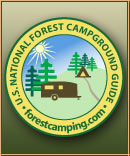Forest Information
The Nicolet National Forest is located in the northeast corner of
northern Wisconsin. The Forest is comprised of 658,000 acres.
There are 22 developed campgrounds, 19 of which meet the
selection criteria.
The Nicolet National Forest, named for the 1634 French explorer, Jean Nicolet, offers its visitors a variety of recreation options, including great camping locations, in the beautiful northern forest. Spring bring new life to the Forest, home to some 51 species of mammals, from black bear and timber wolf to white-tail deer and shrew and a robust and healthy woods of Aspen, maple, pine, cedar, spruce and fir. Summer time is the best time for visitors to enjoy recreation opportunities available in the Forest's sparkling blue water. Fall, with the brilliant autumn colors and cooler temperatures, is for hikers, mountain bikers, and equestrians. The quiet splendor settling over the Nicolet in the winter is best seen by snow enthusiasts, such as cross-country skiers. With the arrival of spring the cycle begins again.
It is said the developed car, tent, recreational vehicle (RV) and motorhome camping ". . . in the Nicolet National Forest provides a calm, close to nature experience." While none are within a designated wilderness area (dispersed camping is permitted here but not included in this campground directory), most do provide a wilderness camping experience without campers having to backpack in. Anvil Lake is convenient to the Blackjack Spring Wilderness. Luna-White Deer Lake campground is near Headwaters Wilderness. While Lost Lake and Chipmunk Rapids (which did not meet the authors' criteria) campgrounds are not as near a Wilderness area, they are located on the 9-mile Lauterman Trail which does access the Whisker Lake Wilderness.
Eight-hundred miles of trails crisscross the Nicolet National Forest. Hiking, mountain biking, and equestrian trails provide visitors a means to explore the Forest's summertime beauty. Cross-country, snowmobile, and dog sled trails give visitors access to its winter splendor. Trails range in length and difficulty from Spring Lake Fire Interpretive Trail at a quarter-mile over gently rolling terrain to 80-mile Eagle River Self-guided National History Auto Tour. For most trails there is a developed campground nearby so visitors can explore at their leisure.
Sevenmile Lake Trail, adjacent to the campground of the same name, offers a stroll through a bog. Hikers along this trail will enjoy vistas of two lakes and many plants, such as sundew, pitcher plant, and various orchids, unique to a bog environment. Boulder Lake campground Trail offers hikers and mountain bikers more of a challenge over rolling terrain up though boulder dotted ridges. The Bailey Lake Equestrian Trail attracts trail users from far and near to enjoy the tall Red pine forest.
Another method of exploring the Nicolet National Forest is on an Auto Tour. The Heritage Drive National Forest Scenic Byway, located near Eagle River, WI, follows portions of a route traveled by Native Americans for hundreds of years. Later, it was used by European settlers to expand the northern frontier and then eventually automobile traffic. In the southern section of the Forest is the 65-mile Lakewood Auto Tour. Boot Lake campground is convenient to this Auto Tour but information and Tour brochures are available only at the Lakewood Ranger District Office. Both Trails focus on the Forest's beautiful scenery and historic points of interest.
The Nicolet National Forest boasts of having over 2,000 archeological and historic sites. Many of these sites are not easy to find. An exception is at Franklin Lake campground. Here, the handiwork of the Civilian Conservation Corps (CCC) can be seen all around. Historic log and stone structures are scattered throughout the campground. Regular programs are offered to help visitors learn and appreciate the important contribution of this Depression Era organization. Another indications of the CCC's importance to the Nicolet can be seen in the many tree plantations found in the Forest. The neat, orderly rows, appearing to be frozen in a military marching formation, are a dead give-away to the CCC origin of the Red pine woodlands. For more information and an opportunity to assist in the Heritage Resource ask about Passport in Time projects.
The Nicolet National Forest has over 1,200 lakes and rivers. The natural diversity of so many waterways attracts visitors looking for swimming, boating, canoeing, rafting, and fishing in crystal clear water. Various trout species, Northern pike, walleye, muckellunge (muskie), bass, and panfish are found throughout the Forest. Canoeing enthusiasts enjoy exploring Brule, Pine, Oconto and Wolf rivers, to name a few.
With so much moist and lush woodlands, the Nicolet National Forest has its share of insects. Early summer through July is mosquito time. Black flies are common soon after the snow melts until mid-June. When the weather turns dry and warm in the months of June and July, deer flies are out. And ticks are about the whole Summer season. It is recommended visitors bring a good quality insect repellent for the biting bug and check periodically for ticks.
The Nicolet National Forest is a land of beauty and recreation in a setting of tall trees and scenic lakes. Season to season, year to year, day to day, there will always be as many ways to enjoy this Forest as there are visitors to the Forest.
ADDRESSES
SUPERVISOR ADDRESS
500 Hanson Lake Rd.
Rhinelander, Wisconsin 54501
715-362-1300
RANGER DISTRICT ADDRESSES
Eagle River-Florence
1247 E Wall St.
Eagle River, Wisconsin 54521
715-479-2827
Laona-Lakewwod
4978 Hwy 8 W
Laona, Wisconsin 54541
715-674-4481 |
